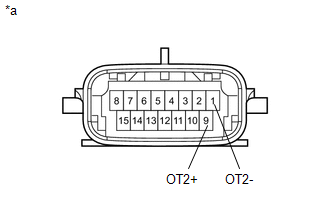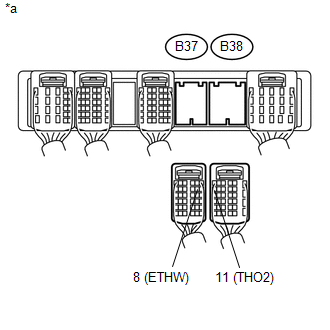Toyota 4Runner: Transmission Fluid Temperature Sensor "B" Circuit Low Input (P2742,P2743)
DESCRIPTION
The Automatic Transmission Fluid (ATF) temperature sensor is on the transmission, just in front of the oil cooler inlet pipeline.
If the ECM detects an abnormally high ATF temperature near this sensor, it illuminates the warning light.
HINT:
- The temperature of the ATF easily rises when towing, climbing hills, in traffic, etc.
- If the ATF temperature sensor becomes short-circuited, the signal that indicates that the ATF temperature is 150°C (302°F) or higher is input into the ECM.
Vehicle conditions when the sensor is normal and when the sensor is short-circuited are indicated in the table below.
|
No. 2 ATF Temperature Sensor State |
Detection Condition |
Symptom |
Recovery Condition |
|---|---|---|---|
|
Sensor is normal |
ATF temperature higher than 150°C (302°F) |
ATF temperature warning light remains ON |
ATF temperature below 135°C (275°F)*1 |
|
ATF temperature higher than 130°C (266°F) |
Shift point too high |
ATF temperature below 110°C (230°F) |
|
|
Conditions (a) and (b) are met: (a) ATF temperature higher than 130°C (266°F) (b) Engine coolant temperature higher than 95°C (203°F) |
Lock-up in 3rd gear*2 |
ATF temperature below 110°C (230°F)*1 and engine coolant temperature higher than 95°C (203°F) |
|
|
Sensor is short-circuited |
Any conditions |
|
Symptoms still occur |
|
Engine coolant temperature higher than 95°C (203°F) |
Lock-up in 3rd gear*2 |
Symptoms still occur |
HINT:
*1: When ATF temperature is in the normal range, it decreases to below 135°C (275°F) within 5 minutes with the shift lever in P or N in an idling state.
*2: When ATF temperature is normal, transmission lock-up occurs in 5th gear with the shift lever in D or with the S5 range selected, and in 4th gear with the S4 range selected.
|
DTC Code |
DTC Detection Condition |
Trouble Area |
|---|---|---|
|
P2742 |
No. 2 ATF temperature sensor resistance is below 25 Ω (0.046 V) for 0.5 sec. or more (1-trip detection logic). |
|
|
P2743 |
ATF temperature sensor resistance is higher than 156 kΩ (4.915 V) for 0.5 sec. or more and either condition is met (1-trip detection logic): (A) 15 min. or more have elapsed after the engine start when the engine coolant temperature or intake air temperature is -29.375°C (-20.875°F) or less. (B) 10 sec. or more have elapsed after the engine start when the engine coolant temperature and intake air temperature are higher than -29.375°C (-20.875°F). |
|
MONITOR DESCRIPTION
The ATF temperature sensor converts the ATF temperature into an electrical resistance value. Based on the resistance, the ECM determines the ATF temperature, and the ECM detects an open or short in the ATF temperature circuit. If the resistance value of the ATF temperature sensor is below 25 Ω*1 or higher than 156 kΩ*2, the ECM interprets this as a fault in the ATF sensor or wiring. The ATF temperature warning light blinks and the ECM stores the DTC.
HINT:
- *1: 150°C (302°F) or higher is indicated regardless of the actual ATF temperature.
- *2: -40°C (-40°F) is indicated regardless of the actual ATF temperature.
- The ATF temperature can be checked on the Techstream display.
WIRING DIAGRAM
Refer to DTC P0712 (See page .gif) ).
).
CAUTION / NOTICE / HINT
NOTICE:
Perform the universal trip to clear permanent DTCs (See page
.gif) ).
).
1. DATA LIST
HINT:
Using the Techstream to read the Data List allows the values or states of switches, sensors, actuators and other items to be read without removing any parts. This non-intrusive inspection can be very useful because intermittent conditions or signals may be discovered before parts or wiring is disturbed. Reading the Data List information early in troubleshooting is one way to save diagnostic time.
NOTICE:
In the table below, the values listed under "Normal Condition" are reference values. Do not depend solely on these reference values when deciding whether a part is faulty or not.
(a) Warm up the engine.
(b) Turn the ignition switch off.
(c) Connect the Techstream to the DLC3.
(d) Turn the ignition switch to ON.
(e) Turn the Techstream on.
(f) Enter the following menus: Powertrain / Engine and ECT / Data List.
(g) According to the display on the Techstream, read the Data List.
Engine and ECT|
Tester Display |
Measurement Item/Range |
Normal Condition |
Diagnostic Note |
|---|---|---|---|
|
A/T Oil Temperature 2 |
No. 2 ATF temperature sensor value/ Min.: -40°C (-40°F) Max.: 215°C (419°F) |
|
If the value is -40°C (-40°F) or 215°C (419°F), the No. 2 ATF temperature sensor circuit is open or shorted. |
HINT:
- When DTC P2742 is output and the Techstream output is 150°C (302°F) or higher, there is a short circuit.
- When DTC P2743 is output and the Techstream output is -40°C (-40°F),
there is an open circuit.
Check the temperature displayed on the Techstream in order to check if a malfunction exists.
|
Temperature Displayed |
Malfunction |
|---|---|
|
-40°C (-40°F) |
Open circuit |
|
150°C (302°F) or higher |
Short circuit |
PROCEDURE
|
1. |
INSPECT TRANSMISSION WIRE (NO. 2 ATF TEMPERATURE SENSOR) |
|
(a) Disconnect the B32 transmission wire connector. |
|
(b) Measure the resistance according to the value(s) in the table below.
Standard Resistance:
|
Tester Connection |
Condition |
Specified Condition |
|---|---|---|
|
1 (OT2-) - 9 (OT2+) |
Always |
25 Ω to 156 kΩ |
|
1 (OT2-) - Body ground |
Always |
10 kΩ or higher |
|
9 (OT2+) - Body ground |
Always |
10 kΩ or higher |
HINT:
If the resistance is out of the specified range at one of the ATF temperatures shown in the table below, the driveability of the vehicle may decrease.
Resistance (Reference):
|
ATF Temperature |
Specified Condition |
|---|---|
|
10°C (50°F) |
5 to 8 kΩ |
|
25°C (77°F) |
2.5 to 4.5 kΩ |
|
110°C (230°F) |
0.22 to 0.28 kΩ |
|
*a |
Component without harness connected (Transmission Wire) |
| NG | .gif) |
REPAIR OR REPLACE NO. 2 ATF TEMPERATURE SENSOR (TRANSMISSION WIRE) |
|
|
2. |
CHECK HARNESS AND CONNECTOR (TRANSMISSION WIRE - ECM) |
|
(a) Disconnect the B37 and B38 ECM connectors. |
|
(b) Measure the resistance according to the value(s) in the table below.
Standard Resistance:
|
Tester Connection |
Condition |
Specified Condition |
|---|---|---|
|
B38-11 (THO2) - B37-8 (ETHW) |
Always |
25 Ω to 156 kΩ |
|
B38-11 (THO2) - Body ground |
Always |
10 kΩ or higher |
|
B37-8 (ETHW) - Body ground |
Always |
10 kΩ or higher |
|
*a |
Rear view of wire harness connector (to ECM) |
| OK | .gif) |
REPLACE ECM |
| NG | .gif) |
REPAIR OR REPLACE HARNESS OR CONNECTOR |
 Torque Converter Clutch Pressure Control Solenoid Performance (Shift Solenoid
Valve SLU) (P2757)
Torque Converter Clutch Pressure Control Solenoid Performance (Shift Solenoid
Valve SLU) (P2757)
DESCRIPTION
The ECM uses the signals from the throttle position sensor, air-flow meter, turbine
(input) speed sensor, output speed sensor and crankshaft position sensor to monitor
the engagement ...
 Pressure Control Solenoid "D" Electrical (Shift Solenoid Valve SLT) (P2716)
Pressure Control Solenoid "D" Electrical (Shift Solenoid Valve SLT) (P2716)
DESCRIPTION
Refer to DTC P2714 (See page ).
DTC Code
DTC Detection Condition
Trouble Area
P2716
Open or short is detected in the shift s ...
Other materials about Toyota 4Runner:
Reassembly
REASSEMBLY
CAUTION / NOTICE / HINT
HINT:
Use the same procedure for the RH and LH sides.
The procedure listed below is for the LH side.
PROCEDURE
1. INSTALL FRONT TURN SIGNAL LIGHT BULB
(a) Install the front turn signal light bulb to th ...
Disassembly
DISASSEMBLY
PROCEDURE
1. FIX REAR DIFFERENTIAL CARRIER ASSEMBLY IN PLACE
2. INSPECT RUNOUT OF REAR DRIVE PINION COMPANION FLANGE SUB-ASSEMBLY REAR
(a) Using a dial indicator, measure the runout of the companion flange vertically
and laterally.
Dista ...


.gif)
